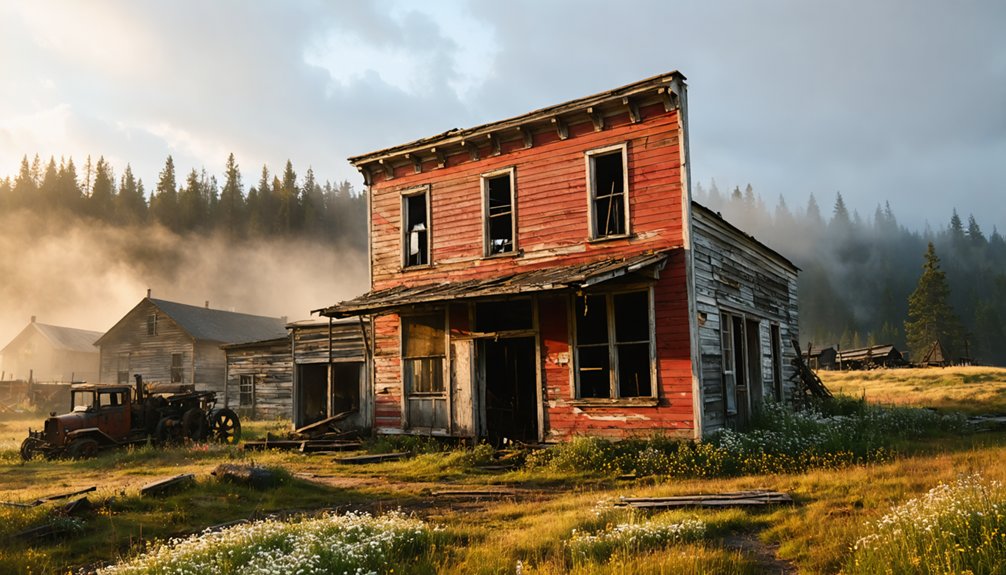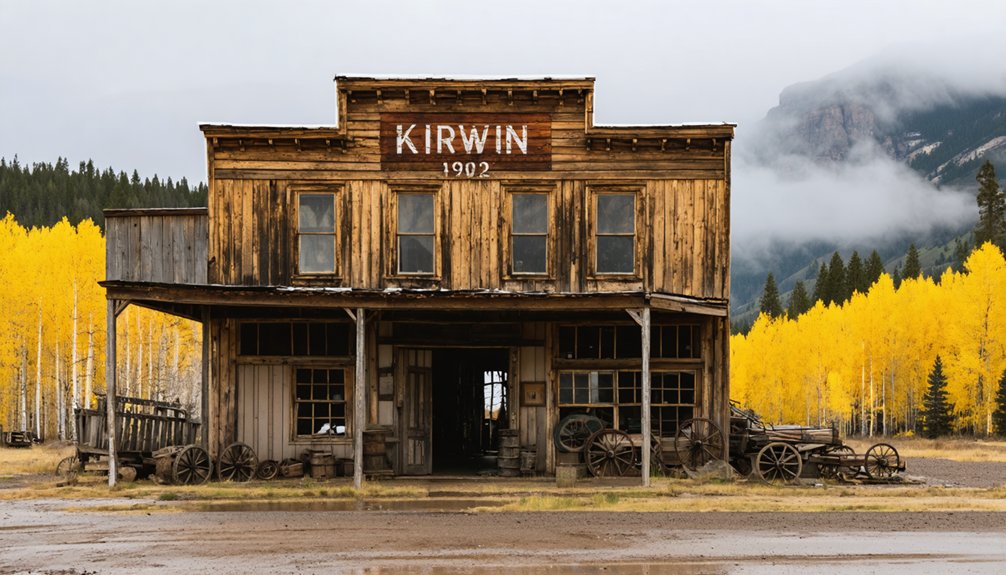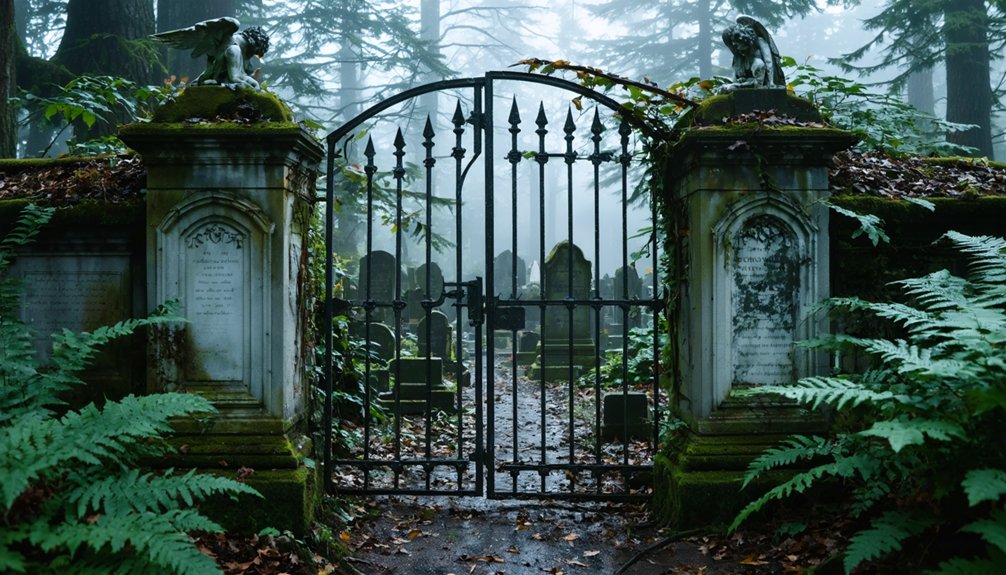You’ll discover fascinating ghost towns across the Pacific Northwest, from Monte Cristo’s silver-rich peaks to Garnet’s 80 preserved structures. These abandoned settlements showcase the region’s mining heritage through weathered buildings, rusting equipment, and tales of frontier life. Explore Shaniko’s wool empire remnants, Govan’s mysterious past, and Coloma’s “Mystery Camp” along remote dirt roads and mountain passes. Each ghost town holds untold stories of boom-and-bust cycles waiting to be uncovered.
Key Takeaways
- Monte Cristo offers scenic hiking trails to explore 15 preserved building ruins and remnants of the world’s largest aerial tramway.
- Garnet’s 80 original structures and thirteen saloons make it one of the best-preserved ghost towns in the Pacific Northwest.
- Molson features both Old and New Town ruins, with free access to mining equipment displays and an open-air museum.
- Sumpter Valley showcases distinctive gold mining history through 72 one-ton dredge buckets and extensive tailing piles.
- Keystone’s remote silver mining ruins require 4WD access but reward visitors with authentic frontier structures and mining equipment.
Monte Cristo: Washington’s Hidden Mining Legacy
Nestled in a remote valley of Washington’s Northern Cascades, Monte Cristo stands as one of the Pacific Northwest’s most intriguing ghost towns.
You’ll discover the remnants of a once-bustling boomtown that flourished after silver’s discovery in 1889, growing to 1,000 residents by 1894.
Despite Rockefeller’s syndicate investing heavily in the mines, mounting mining challenges proved insurmountable. The erratic ore deposits, harsh winters, and devastating floods created perfect conditions for economic decline. The historic aerial tramway was once considered the largest of its kind in the world.
By 1907, the mines had played out, and the town’s population dwindled.
Today, you can explore the ruins of about 15 buildings, following hiking trails that trace old mining roads. A massive concentrator mill once processed up to 300 tons of ore daily during the town’s peak operations.
While floods have damaged access routes, the site’s isolation has preserved this remarkable piece of Washington’s mining heritage, beckoning adventurous spirits to uncover its stories.
Garnet: Montana’s Best-Preserved Mountain Settlement
Among Montana’s surviving ghost towns, Garnet stands as a remarkable time capsule perched at 6,000 feet in the pine-covered Garnet Mountain Range. Founded in 1895 during the gold mining boom, this untouched settlement offers you unparalleled ghost town photography opportunities with over 80 original structures frozen in time. The town’s name comes from the ruby-colored stones discovered in the surrounding area. With thirteen saloons operating during its prime, Garnet was a bustling hub of social activity.
For history enthusiasts and adventurous spirits, Garnet delivers:
- Authentic buildings with original furnishings, preserved but not restored by the Bureau of Land Management
- Access to building interiors where miners and merchants once conducted daily life
- A glimpse into a thriving 1890s community that once supported 1,000 residents
- Dramatic mountain scenery and genuine historical preservation without commercial development
You’ll find Garnet 40 miles east of Missoula, accessible by dirt roads in summer or snowmobile in winter.
Govan: Mysteries of the Eastern Washington Plains
While most ghost towns fade quietly into history, Govan’s dark past sets it apart as one of the Pacific Northwest’s most haunting abandoned settlements.
You’ll find this former railroad hub on Washington’s eastern plains, where it thrived until a devastating 1927 fire and the rerouting of Highway 2 sealed its fate.
But it’s the unsolved murders that truly define Govan’s legacy – from the brutal 1902 axe killing of Judge Lewis and his wife to the chilling 1941 double homicide that wasn’t fully uncovered for eight years.
Before tragedy struck, Govan was a thriving farming community with a post office and numerous homesteads.
Today, you can explore the haunting remains of the 1906 schoolhouse, where Govan ghost stories tell of a wandering teacher’s spirit amid flickering lights and unexplained sounds.
Much like the nearby Gobin schoolhouse’s deteriorating roof, the Govan school structure has fallen into severe disrepair over the decades.
With just three residents remaining, the town’s abandoned structures stand as silent witnesses to its violent past.
Shaniko: Oregon’s Wool Empire Ghost Town
The rise and fall of Shaniko stands as one of Oregon’s most dramatic ghost town tales.
Once crowned the “Wool Capital of the World,” this remote outpost flourished in the early 1900s, shipping millions of pounds of wool via the Columbia Southern Railroad. In 1903, the town generated an astounding $3,000,000 in wool profits.
When fire struck and railways bypassed the town in 1911, Shaniko’s wool industry empire crumbled, transforming it into the fascinating ghost town you’ll discover today. The town’s population drastically fell from its peak of six hundred residents during its glory days.
- Explore the newly refurbished Shaniko Hotel, a symbol of the town’s former grandeur
- Wander past preserved Old West storefronts and authentic wooden boardwalks
- Visit the original sheep sheds that once housed the region’s mighty wool trade
- Time your visit during summer festivals to experience the town at its liveliest
Today, with just 25 residents, Shaniko offers you an authentic glimpse into the untamed spirit of Oregon’s frontier past.
Coloma: Lost Treasures in Montana’s Wilderness
Hidden within Montana’s rugged Garnet Mountain Range, Coloma beckons adventurous explorers with its mysterious past as a turn-of-the-century gold mining settlement.
You’ll discover a town that yielded $250,000 in precious metals between 1896 and 1916, earning its nickname as the “Mystery Camp” due to its scarce historical records.
Coloma history reveals tales of frontier life, including a dramatic 1902 shooting at the Red Front Saloon over a broken marriage promise.
At 5,928 feet elevation, you’ll find scattered remnants of narrow-gauge railroad tracks and mining equipment among the ghost town‘s sparse ruins.
Local Coloma folklore even suggests Butch Cassidy once passed through, though you’ll need to decide for yourself if that’s fact or fiction.
Today, researchers from the University of Montana continue studying the site to uncover more about its rich mining heritage.
The site exemplifies the importance of historical preservation efforts in maintaining these cultural landmarks for future generations.
Visit between May and January when roads are accessible.
Sumpter: Gold Rush Relics of Eastern Oregon
You’ll find an impressive array of preserved mining equipment in Sumpter, including the towering Sumpter Valley Gold Dredge that processed millions in gold between 1935 and 1954.
The historic main street, though diminished from its 3,500-resident heyday, still showcases original frontier architecture from when the town boasted seven hotels, sixteen saloons, and two banks.
Walking through Sumpter today, you can explore both the restored dredge, now a State Heritage site, and the weathered buildings that tell the story of Eastern Oregon’s richest gold mining settlement.
Mining Equipment Still Stands
Standing like a massive metal sentinel in Oregon’s Sumpter Valley, a restored gold dredge dominates the landscape as one of the Pacific Northwest’s most impressive mining relics.
This remarkable piece of dredge mechanics processed massive amounts of earth in its relentless pursuit of gold, operating almost continuously from 1935 to 1954.
Thanks to mining preservation efforts, you’ll find this engineering marvel anchored near the town center, where it serves as a symbol of the region’s rugged mining heritage.
- Explore the 72 one-ton buckets that once churned through the valley floor
- Witness the innovative sluice system that separated precious gold from ordinary dirt
- Walk among the distinctive tailing piles that stretch across the landscape
- Discover two additional historic dredge sites scattered throughout the valley
Preserved Historic Main Street
Steeped in gold rush history, Sumpter’s preserved main street transports you back to the late 1800s when this Eastern Oregon boomtown buzzed with the energy of 3,500 prospectors, merchants, and adventurers.
You’ll walk the same wooden planks that once supported the traffic of sixteen saloons, seven hotels, and an opera house during the town’s golden era.
While a devastating 1917 fire claimed many original buildings, surviving historic structures stand as evidence to frontier architecture, with their wooden facades and false fronts intact.
Today, the tourism impact breathes new life into these preserved remnants. You can pan for gold nearby, catch reenacted train robberies, or explore the Sumpter Valley Railway Depot – all while experiencing an authentic slice of Pacific Northwest mining heritage.
Hell Gate Ronde: Trading Post to Ghost Town
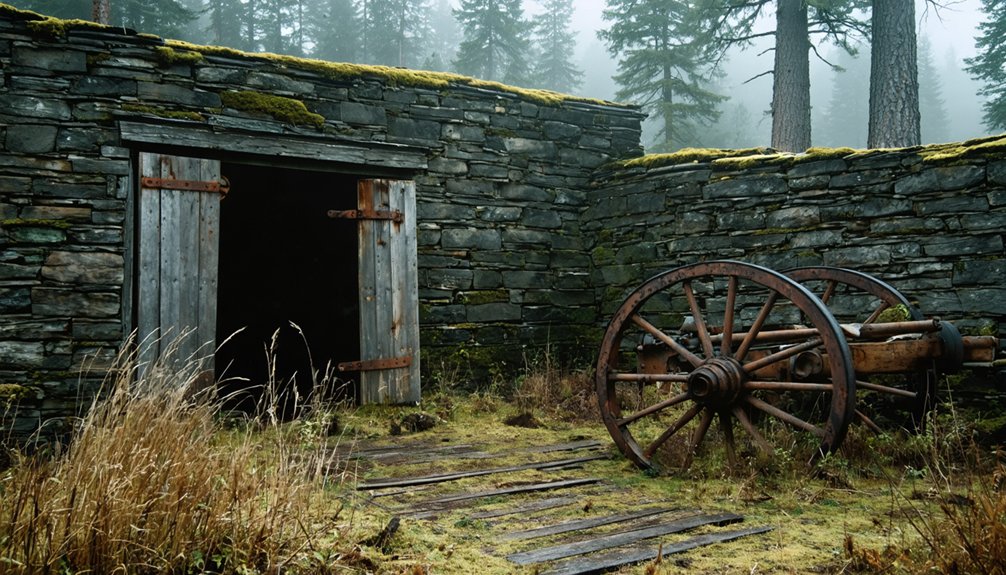
When you travel to Hell Gate Ronde, you’ll find yourself on the historic Mullan Road, where French-Canadian fur trappers established this essential trading hub in the 1850s.
Along this 633-mile trade route, Worden and Higgins’ trading post became a bustling center for commerce between settlers, indigenous peoples, and prospectors, though it also gained notoriety for its lawless atmosphere.
The site’s transformation from a thriving frontier post to an abandoned ghost town mirrors countless boom-and-bust cycles of the Pacific Northwest, with only a brown storage shed now marking where treasury notes once changed hands and vigilantes once roamed.
Historical Trading Routes
Although French-Canadian fur trappers named it in the 1850s, Hell Gate Ronde’s history as an essential trading hub stretches back centuries before European settlement.
This broad valley’s historical significance lies in its natural crossroads, where Native American trails converged with early trade routes, creating a cultural heritage that would shape the Pacific Northwest.
You’ll discover the area’s strategic importance through these key trading connections:
- Mullan’s Road – a 633-mile federal wagon route linking Walla Walla to Fort Benton
- Native American trading paths that crisscrossed the valley
- Gold rush routes connecting miners to essential supplies
- French-Canadian fur trading networks that extended throughout the region
The valley’s geography made it a natural gathering point, where freedom-seeking traders, settlers, and indigenous peoples exchanged goods and stories beneath the surrounding mountains.
Law and Order Legacy
Despite its promising start as a trading post in 1860, Hell Gate Ronde’s reputation quickly transformed into that of an outlaw haven.
You’ll find the remnants of frontier justice in the stories of Worden’s store, where impromptu trials took place during the lawless 1860s. When official law enforcement proved nonexistent, a Vigilance Committee from Alder Gulch took matters into their own hands during the winter of 1863-1864, confronting and hanging suspected gang members.
The community’s struggle for order shaped future governance models in the Pacific Northwest.
At Camp Humphreys, settlers worked alongside military personnel to maintain security, while Judge F.H. Woody’s shift from frontier chaos to becoming Missoula’s first mayor exemplifies how this wild outpost eventually gave way to formal law and civilization.
Molson: Abandoned Dreams at the Canadian Border
The promise of gold drew ambitious prospectors to Molson in 1898, transforming a remote stretch of Washington’s Canadian border into a bustling frontier town.
Fortune seekers flocked to Molson’s gold fields in 1898, building a thriving frontier outpost along Washington’s northern edge.
What you’ll discover today is a remarkably preserved slice of frontier life, where two competing towns once fought for supremacy in a decades-long feud that defined Molson’s history.
When you visit this fascinating ghost town museum, you’ll find:
- Original structures from both Old and New Molson, including the contentious post office that residents literally stole in the night
- Authentic mining equipment and artifacts from the $170,000 investment that sparked the town’s creation
- A preserved Union High School that educated the children of 700 peak residents
- Free year-round access to explore this open-air museum, where local volunteers share tales of frontier dreams
Keystone: Remote Montana Mining Adventures
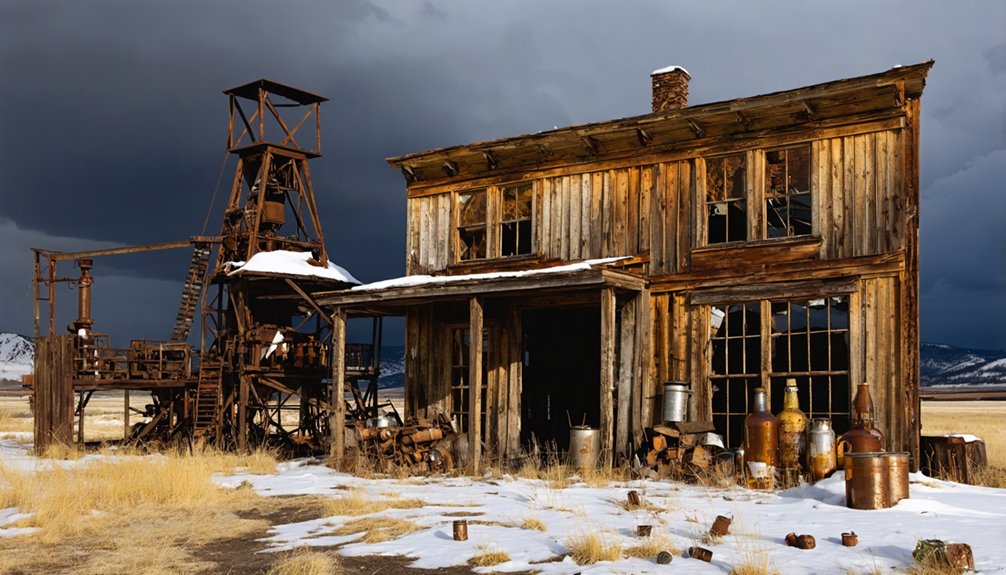
You’ll find this abandoned Montana silver town tucked away in the remote wilderness northwest of Superior, where old mining structures still dot the rugged landscape along Keystone Creek.
While most of Keystone’s infrastructure has vanished since its 1890s heyday, you can still explore weathered cabins and mining remnants that hint at the town’s prosperous past when 500 residents called it home.
The site requires traversing dirt roads to access, but you’re rewarded with an authentic glimpse into the boom-and-bust cycle of Western mining history amid the peaceful mountain setting.
Mining Equipment Still Stands
Standing defiantly against time and weather, scattered mining equipment dots Keystone’s rugged landscape, offering visitors a rare glimpse into Montana’s frontier mining operations.
You’ll discover weathered remnants of both placer and hard rock mining methods, preserved by the site’s remote location and challenging terrain.
- Rustic ore carts and stamp mills showcase the evolution from simple gold panning to industrial-scale mining.
- Linear arrangements of machinery reveal organized extraction patterns across the mountainside.
- Metal framework and wooden supports mark the entrances to historic mine shafts.
- Tailings piles and sluice systems demonstrate the scope of gold processing operations.
As you explore these mining relics, you’re walking through an authentic outdoor museum of frontier ingenuity, where each piece of equipment tells a story of determination and grit.
Backcountry Access Required
Reaching Keystone’s remote mining ruins requires careful planning and a spirit of adventure, as this historic site lies deep within Montana’s challenging backcountry terrain.
You’ll need a high-clearance 4WD vehicle to navigate the unmaintained forest roads, and during wet seasons, you might’ve to proceed on foot. Don’t count on cell service in these remote areas.
Before setting out, check with the Forest Service about current road conditions and access permissions.
You’ll want to pack essential safety precautions: extra water, emergency supplies, and reliable navigation tools. The site’s isolation means you’re largely on your own if problems arise.
Weather conditions can change rapidly in Montana’s mountains, so timing your visit during the dry season will give you the best chance of reaching these fascinating remnants of frontier mining history.
Sherman: Homesteading History Frozen in Time
A haunting reminder of frontier life awaits in Sherman, Washington, where the remnants of a once-thriving homesteading community rest quietly in a natural gully 15 minutes northeast of Govan.
You’ll discover a reflection of homesteading struggles through the weathered structures that tell tales of determination and hardship in the American West.
- Stand before the iconic white church perched on higher ground, a favorite among ghost town exploration enthusiasts.
- Walk among the gravestones that chronicle the lives of Civil War veterans who sought new beginnings.
- Witness the abandoned schoolhouse and post office that served the community until the 1940s.
- Explore the site where settlers endured the devastating blizzard of 1889, surviving on potatoes and salt.
The dirt road through farmland leads you to this perfectly preserved slice of Pacific Northwest history.
Frequently Asked Questions
What Survival Gear Should I Pack When Visiting Remote Ghost Towns?
Like a prepared explorer charting unknown waters, you’ll need survival essentials: GPS, maps, water, food, first-aid kit, sturdy boots, protective clothing, emergency shelter, and outdoor safety gear including flashlights.
Are Any Pacific Northwest Ghost Towns Still Inhabited by Year-Round Residents?
You’ll find several inhabited towns like Molson and Shaniko maintaining their historical significance, where year-round residents operate tourism businesses, preserve historic buildings, and embrace the solitude of these remarkable places.
Which Ghost Towns Allow Metal Detecting or Artifact Collecting?
Like striking gold, you’ll find Hardman welcoming to metal detecting. Check local regulations, get permissions, and remember most sites require reporting historical artifacts over 100 years old to authorities.
How Dangerous Are Wildlife Encounters in These Abandoned Settlements?
You’ll face minimal danger if you practice proper wildlife safety – make noise, carry bear spray, and travel in groups. While bears and cougars exist, encounter precautions greatly reduce any serious risks.
Can You Legally Camp Overnight in Pacific Northwest Ghost Towns?
You’ll need to check local camping regulations, as legality varies by land ownership. Most ghost towns on federal lands allow dispersed camping, but those on private property require permission to preserve historic sites.
References
- https://www.newmexico.org/places-to-visit/ghost-towns/
- https://en.wikipedia.org/wiki/Wikipedia:WikiProject_Ghost_towns
- https://stateofwatourism.com/ghost-towns-of-washington-state/
- https://getpodcast.com/at/podcast/rv-out-west/13-ghost-towns-across-the-pacific-northwest_c0803b3f67
- https://glaciermt.com/ghost-towns
- http://pnwphotoblog.com/ghost-towns/
- https://pnwbookreview.com/ghost-towns-of-the-pacific-northwest.html
- https://www.youtube.com/watch?v=CuEIWySDQ20
- https://traveloregon.com/things-to-do/culture-history/ghost-towns/
- https://www.youtube.com/watch?v=38L_AbI-B1Y
